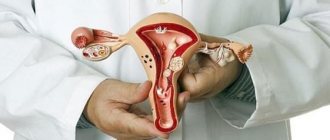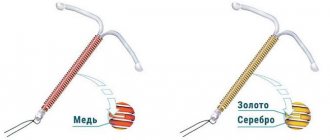Hematometra after cesarean section is a retention of blood in the uterus. It appears when there is an obstacle to the outflow of postpartum secretions, cervical spasm, or insufficient contraction of the uterine cavity. This complication can be suspected if there is a sudden cessation of discharge at the end of the first week, heaviness and pain in the lower abdomen. Gynecological examination, ultrasound and hysteroscopy help confirm the diagnosis.
For treatment, Oxytocin and drugs to relax the cervix (No-shpa, Spazmalgon) are first prescribed. If ineffective, vacuum aspiration is used; in very severe cases, removal of the uterus may be necessary. You should not delay a visit to the doctor and use folk remedies, as they do not give the desired result, but lead to a late start of therapy, the addition and spread of infection.
Fluid in the uterine cavity after childbirth and the reasons why it does not come out
The presence of fluid in the uterine cavity after childbirth indicates that the uterus is beginning to return to its original state. The uterus, healing, contracts and pushes out the accumulated fluid and blood. By the nature of the discharge, as well as by the size of the organ, one can judge the normal course of the postpartum period.
Reasons that prevent the uterus from expelling fluid normally:
- the presence of particles of afterbirth;
- accumulation of large blood clots;
- parts of the fetal membrane.
The uterus, in the presence of residual postpartum tissue, cannot contract or contracts, but very weakly. Liquid accumulates in the cavity, which leads to pathology.
A woman needs to remove accumulated fluid from the cavity, which occurs by removing it from the cervical canal. Drug therapy is also prescribed.
Important: A woman must undergo an ultrasound after childbirth to avoid illness. Further accumulation of fluid can lead to irreversible consequences.
Lochia
During childbirth, the uterus is injured. For some time after delivery, she begins to reject everything unnecessary. Remains of the placenta, amniotic membrane, blood, all this must leave the organ. These secretions are called lochia.
For the first 3 days they are bright red and very strong. Then within 5-6 days it turns brown and looks more like menstruation. Further, the consistency becomes more transparent and lasts from 2 weeks to 2 months. It all depends on the characteristics of the body.
Important: If lochia stops within 2 weeks, and then returns with renewed vigor and is colored bright red, this is a reason to urgently consult a doctor.
And also if the discharge stops earlier than the expected period, this is a reason to visit a gynecologist. Perhaps fluid has begun to accumulate in the uterine cavity.
By nature, a lochia gynecologist can analyze how the process of organ restoration proceeds after childbirth. A change in color or character suggests that there is an infection in the body or another disease has begun.
Consequences of the disease
Postpartum discharge is a breeding ground for bacteria, so if clots do not come out, there is a high probability of developing a bacterial infection. A dangerous complication that occurs due to the retention of foreign bodies in the uterus is postpartum endometritis (inflammation of the endometrium). The development of the disease is indicated by:
- increased body temperature;
- pain in the lower abdomen;
- discharge with an unpleasant odor.
The disease develops 2–14 days after birth. Treatment requires cleaning out the uterus with a vacuum or curette, and prescribing medications that are often incompatible with breastfeeding. The disease can lead to infertility or miscarriage in the future.
The formation of clots is normal in the first days after childbirth, but if it occurs after a week or more, you should consult a doctor to determine the cause. A woman should be attentive to her well-being, because her health depends on it.
Involution
Involution involves the return of the uterus to its normal state. After birth, it should take about two months for the organ to return to its original size.
Maximum rapid involution occurs in the first days after delivery. Then the process slows down. After 7 days, the obstetrician and the nature of the discharge can conclude that the uterus is rapidly recovering.
To speed up this process, a woman is recommended to breastfeed her baby. The more the baby feeds on mother's milk, the more the uterus contracts, pushing out the remaining blood and fluid accumulated in it.
Diagnostic measures
Identification of organic particles that remain in the organs occurs during the assessment of involution (reflex reduction) of the uterus and appendages. After childbirth, the following medical procedures are performed:
- questioning the patient about the intensity, duration, consistency of discharge and other characteristic symptoms;
- palpation of the uterus and examination of the birth canal on a gynecological chair;
- ultrasound examination, including echography;
- laboratory analysis of smears and scrapings.
In the normal course of postpartum recovery, the first diagnostic study is carried out a week after birth, the second - after the lochia has stopped (6-8 weeks). Verification of standards for reducing the weight, volume and thickness of the walls of the uterus, as well as examining cavities for accumulation of blood and other fluid, allows you to confirm normal involution or detect problems in time, avoiding complicated inflammatory processes and deformation of organs.
Subinvolution
If the examination reveals that the uterus does not contract and has the same enlarged shape, then this process is called subinvolution. There are two types of pathology:
- infectious;
- true.
It is considered infectious if a woman is sick with pyelonephritis or anemia. It is also possible to get an infection during childbirth. The true one occurs when a woman in labor has polyhydramnios, undergoes a cesarean section, as well as during a multiple or large pregnancy.
A woman, even if she has already left the maternity hospital, must monitor the nature of the discharge. If you have dark-colored discharge with an unpleasant odor, as well as an increase in body temperature, you should visit a gynecologist. If these symptoms are present, the woman in labor begins subinvolution of the uterus, which can lead not only to gynecological diseases, but also to infertility.
Women giving birth after 40 years and under 18 years are at risk. And also women who were unable to put their baby to the breast due to lack of lactation.
If the birth was by cesarean section, then subinvolution is not considered a pathology. Due to the fact that the muscles of the uterine wall have been cut, it is difficult for the organ to quickly return to normal.
Sometimes, during an ultrasound examination, the doctor may make a mistake with the diagnosis, since the bladder was not emptied sufficiently. Therefore, the doctor takes into account the nature of the discharge.
Subinvolution is considered the first sign of the development of endometritis!
Duration of discharge
The duration of uterine discharge after cesarean section depends on a number of factors:
- Height and weight of the newborn. The larger the fetus, the more the uterus stretches, and accordingly, it takes more time to recover. In multiple pregnancies, discharge lasts longer.
- Volume of amniotic fluid. A large amount of anatomical fluid leads to significant damage to the endometrium.
- Order of birth. With a repeat caesarean section or childbirth, the recovery process is faster, because lochia does not last long and is not so abundant.
- Infections. When inflammation occurs after childbirth, the duration of the regeneration period increases.
- Blood clotting. With good performance, the discharge ends faster. When the level of platelets decreases (poor clotting), the period lengthens, lochia occurs profusely.
- Natural feeding. When breastfeeding, a hormone is produced - oxytocin, which accelerates the contractions of the uterus, the restoration of the lining layer occurs faster.
Attention! With a caesarean section, the discharge lasts longer than after a natural birth.
The duration of postpartum bleeding after cesarean surgery is about 60 days. If the discharge continues longer, the woman needs to visit a gynecologist. The average duration of lochia is 45-60 days, deviations of more than 10 days, up or down, are dangerous.
If lochia lasts for a long time after a CS: dangers
Prolonged bleeding is possible in women with insufficient uterine contractility or problems with blood clotting. Such conditions require medical intervention. Prolonged bleeding can cause anemia - a decrease in hemoglobin in the blood. The development of this condition is indicated by the following symptoms:
- dizziness;
- decreased appetite and sudden change in taste preferences;
- decreased breast milk production;
- constant weakness.
The danger is that the mother, for medical reasons, will have to stop feeding the child due to the risk of developing anemia in him.
The discharge stopped quickly
Short bleeding is no less dangerous than prolonged bleeding. If the lochia is gone after CS surgery within 2-3 weeks, it is likely that the uterus has not completely cleared. Particles of the fetal bladder and placenta remain in the cavity, increasing the risk of developing purulent inflammation and proliferation of pathogenic flora.
The complication is characterized by symptoms:
- pain in the lower abdomen;
- nausea and other symptoms of intoxication;
- increased body temperature;
- the appearance of a putrid odor from the genital tract.
If the discharge quickly stops, you need to contact a gynecologist and undergo an ultrasound examination. After visualization, the cause of scanty discharge will be determined; sometimes, the violation of deadlines is associated with the physiological characteristics of the body. This is often possible when several factors overlap: low fetal weight, scanty menstrual bleeding before pregnancy and active blood clotting.
Endometriosis
The most common disease after childbirth is endometriosis. More and more women are seeking treatment for this pathology.
The disease means that during childbirth, parts of the endometrium or blood clots do not come out, but remain inside the uterus and grow to its walls. The disease does not make itself felt at first, but may appear six months after birth.
Factors that cause pathology to appear:
- long labor;
- vaginal rupture;
- perineal rupture;
- tight placenta previa;
- use of obstetric scissors;
- large fruit.
All this can cause pieces of tissue to begin to take root on the walls of the uterus without coming out.
The main symptom of the disease is pain similar to menstruation pain. But even after childbirth, the stomach still hurts with a contracting uterus. For this, you need to visit a doctor a month after being discharged from the hospital. Only through examination can pathology be identified.
What does hematometra mean after cesarean section?
Hematometra after cesarean section is an accumulation of blood inside the uterus of a woman in labor due to obstruction of the outflow of postpartum lochia (wound discharge). The last stage of the operation (as in normal childbirth) is the detachment of the baby's place (placenta). A wound forms in the area of its attachment. For natural healing, the flow of plasma and blood cells and lymph increases.
Normally, the discharge becomes liquid and quickly passes through the cervix and vagina, and the uterus contracts, gradually taking on its prenatal size. If at any stage of cleansing the uterine cavity an obstacle occurs, then blood and the remains of the placenta accumulate, causing stagnation. These bloody masses are a very good environment for the development of infection, which threatens the inflammatory process - endometritis.
We recommend reading the article about discharge after cesarean section. From it you will learn about what lochia looks like after childbirth, its nature and duration, pathological discharge and the reasons for its appearance. And here is more information about temperature after cesarean section.
Causes of complications
Hematometra may appear due to a mechanical obstruction to the outflow of lochia or insufficient contractility of the uterus. With such a complication, a woman in labor may have two or more risk factors at once (see table).
| Group of risk factors | Cause of blood accumulation in the uterus |
| Obstruction at the vaginal level | Anatomical (partial fusion of the walls, underdevelopment), swelling |
| Cervical pathology | Poor distensibility, unpreparedness for childbirth, polyp, fibroid or other tumor, scars, blockage of the internal os with a large clot |
| Blood clotting disorders | Increased bleeding due to severe late toxicosis, drug use, liver or blood disease |
| Decreased uterine contractility | Overdistension (large fetus, polyhydramnios, multiple pregnancy), extensive incision, manual separation of the placenta, severe blood loss, low activity of the woman in labor |
| Uterine diseases | Myoma, inflammation, scar from a previous cesarean section, surgery, inflection (hyperanteflexia) |
Mother's symptoms
Most often, the development of hematometra is observed at the end of the first week after cesarean section. An important feature is the absence of pronounced manifestations. The mother may have pain in the lower abdomen of normal intensity, feel normal and have a normal temperature.
The only sign is a sudden cessation of discharge from the uterus. Normally, lochia should be present by 5-7 days; by this time they have a red or brown tint, then they lighten a little, but are still definitely present. With a good recovery rate, you should expect them to disappear only by the end of 3 weeks after cesarean section.
It is difficult for a woman to independently detect the early symptoms of hematometra, so before being discharged from the maternity hospital, they are examined in a gynecological chair.
During examination, the following is revealed from the uterus:
- pain on palpation (palpation) and attempted displacement;
- increase in size or insufficient reduction;
- high bottom position;
- deviation to the side from the usual location;
- doughy consistency.
Soreness of the uterus upon palpation (palpation)
A woman in labor may also experience swelling, cyanosis of the perineum or labia, or the entrance to the vagina. The cervix is completely closed or the external os is slightly open, but there is no blood or other discharge on it.
Uterine fibroids after childbirth
After a woman gives birth, her hormonal levels begin to change dramatically. The body also undergoes changes. And because of this restructuring, uterine fibroids may arise. It is not necessary that every woman should get this disease. If there is a predisposition or the fibroid was already in the body, but did not reach a large size, then after childbirth it will make itself felt.
In the early postpartum period, fibroids can reach large sizes. This happens due to swelling of the nodes when the myometrium contracts. It happens that the nodes become so swollen that necrosis of the fibroid occurs and then doctors have to remove it.
Uterine fibroids can lead to heavy bleeding, especially during or after childbirth. To save a woman in labor, the entire uterus has to be removed.
When a diagnosis of uterine fibroids is made, a woman needs to breastfeed her baby for as long as possible. This helps to reduce the size of the tumor and nodes.
This disease slows down the involution period and increases the risk of developing various sexually transmitted infections, which leads to slow contraction of the uterus and accumulation of fluid in its cavity.
Since fibroids are benign in nature, a woman after childbirth should not worry too much. You can begin treatment or removal after the body has recovered. There are rare cases where a fibroid discovered after childbirth quickly develops into a sarcoma.
How to get clots out after childbirth
I did the press 10 times with great difficulty, and after half an hour these clots came out of me. Maria Borisovna January 30 And the figure leaves much to be desired after There were clots - 3 days of oxytocin in the RD - everything worked out, thank God. In what cases is this manipulation necessary? After the birth of the placenta, there was severe bleeding - the reasons are unclear. And so – lochia is normal.
These manipulations are necessary to assess the woman’s condition. Because you can overdo it and provoke bleeding. Hello, I have a similar situation, only I had MA in January by medical.
What to do if blood clots appear after childbirth. Remnants of the placenta, mucus and blood clots continue to come out throughout the postpartum period. Therefore, if there is a clot in the uterus after childbirth, women try to eat foods that contain it. These are lemon, cabbage, parsley, oranges and so on. What can a woman do on her own? Weight correction center “iWaist” is what you need! Complain. We did the washing. the clots came out. it doesn't hurt. After giving birth, my uterus did not contract at all. Before discharge, they did an ultrasound, the uterus was enlarged by 20 weeks and there were no clots. On the same day I was cleaned. More.
Childbirth is a complex physiological process that involves a great deal of physical and psychological stress on a woman’s body and a certain degree of risk to her health. Full recovery of the body occurs no earlier than weeks after the birth of the baby. One of the natural manifestations of cleansing the body is blood discharge from the uterus, which begins immediately after childbirth.
Very often, the discharge is similar to heavy menstruation and comes out along with clots. Many women, not knowing the causes of clots after childbirth, experience fear, viewing them solely as a pathology. However, in most cases this is not the case.
Source
Fluid in the cervix after childbirth
Fluid can accumulate both in the uterine cavity and in the cervix if its exit is hampered by any obstacle. It could be:
- myoma;
- narrowing of the cervical canal;
- myomatous nodes;
- blood clots;
- endometriosis.
In old age, the internal pharynx narrows, which also leads to fluid accumulation. But this is not always a pathology.
The most common cause of fluid in the cervix is the presence of a cyst. The nature of the accumulations is purulent or serous. A cyst occurs due to the presence of inflammatory processes. This pathology is treated by removal.
Rarely occurs in women immediately after childbirth, because it takes time for a cyst to develop in the cervix.
To avoid fluid accumulation in the uterus after childbirth, you need to monitor your health. React to the nature of the pain, as well as to the discharge. Maintain genital hygiene. Breastfeed your baby for as long as possible.
Be sure to undergo a routine examination by a gynecologist, and do not neglect ultrasound diagnostics. By following all these rules, a woman will be able to fully enjoy the period of motherhood.
Video: a month after giving birth
Shall we chat? A month after giving birth. How did it go? Problems and joys.
Treatment
Clots in the uterus can be detected using an ultrasound or during an examination. The existence of a problem is indicated by the size of the reproductive organ. After childbirth, the uterus contracts intensively and returns to its original appearance, but the presence of foreign bodies inside does not allow it to shrink to the desired state.
If clots are found in the uterus, the doctor may try to remove them manually by pressing on the woman's abdomen. This procedure is painless, only discomfort is possible. If the patient feels severe pain, then there is a high probability of developing an inflammatory process.
In some cases, to remove clots, it is enough to press on the woman’s stomach and administer Oxytocin
In addition to manual removal of clots, they resort to vacuum aspiration and cleaning with medical instruments.
Experts recommend resorting to curettage only when drug therapy does not produce a positive result.
Vacuum aspiration
Vacuum cleaning is the removal of remnants of the placenta, membranes, and blood clots from the uterus using a special device that creates negative pressure and absorbs all formations inside. To carry out the procedure, a special cannula is inserted into the reproductive organ - a tube with a hole through which everything unnecessary comes out. It is connected to a pump with a flask for collecting secretions.
Vacuum aspiration is considered a more gentle method of removing clots than conventional cleaning. It minimizes possible injuries to the endometrium and cervix and is performed under local anesthesia.
Mechanical cleaning
Mechanical cleansing (or curettage) is the removal of clots, remnants of the placenta and fetal membranes, along with the tissue lining the uterine cavity (endometrium), from the reproductive organ. This procedure is often carried out when a placental polyp forms - a piece of placenta tightly attached to the walls of the reproductive organ.
Curettage of the uterus is carried out with a special sharp instrument - a curette.
Mechanical cleaning is painful, so it is carried out only under general anesthesia. After curettage, the formation of adhesions, menstrual irregularities and even infertility are possible, so there must be strict indications for prescribing the procedure.
Video: curettage after childbirth and postpartum endometritis
Drug therapy
If after childbirth the clots do not leave the uterus, then in addition to their removal it is necessary to prescribe medications:
- increasing the contractility of the myometrium;
- antibacterial;
- relieving spasm of smooth muscles.
In most cases, despite the prescription of antibiotics, doctors do not prohibit breastfeeding a newborn.
Table: drugs prescribed to women for clots in the uterus after childbirth
| Drug name | Reason for appointment | Dosage, duration and frequency of use | Contraindications | Side effects | average price |
| Oxytocin | A synthetic hormone is prescribed to stimulate contractile activity of the uterus. | Droppers are placed or intramuscular injections are given 1 or 2 times a day. The duration of therapy is selected individually, but, as a rule, it is 3–5 days. | Hypersensitivity to the drug. |
| Ampoules of 5 ml (10 pcs.) - 35 rub. |
| Augmentin | An antibiotic compatible with breastfeeding is prescribed to prevent or treat inflammation due to clots in the uterus. | The duration of therapy depends on the indications for prescribing the drug and is selected individually. The frequency of use depends on the dosage chosen by the attending physician. |
|
| Tablets depending on dosage - 200–350 rubles. |
| No-shpa | An antispasmodic, prescribed to relieve cervical spasm and promote the removal of clots. According to the instructions, the drug is contraindicated during breastfeeding due to the lack of clinical data on its use. However, in practice, doctors often prescribe No-shpa after childbirth, without prohibiting breastfeeding. | Prescribed as injections 20 minutes before Oxytocin. When used in tablets, the dosage and duration of therapy is determined by the doctor. |
|
| Tablets 6 pcs. — 50 rub. Injection solution 5 ampoules - 90 rub. |
Photo gallery: Oxytocin, Augmentin and No-spa for treating women
Reviews
They injected me with Oxytocin while still in the maternity hospital for clots and everything worked out.
Anna
https://www.baby.ru/blogs/post/125118277–80245423/
There was also a bad involution, due to the fact that the baby is large. I did exercises, injections, and also drank this antibiotic. It didn’t get to the point of cleaning, as we dealt with it with medications and an enema.
Julia Good
https://www.baby.ru/blogs/post/490867820–224349393/?page=2#comments
I had clots, on the third day in the maternity hospital they cleaned them manually, I almost died from pain(((It was kind of terrible(((Oxytocin did not help at all.
VictoriaSH
https://www.babyplan.ru/questions/60437-kogda-nachnet-dejstvovat-oksitotsin/
I was given injections of Oxytocin and No-shpa, which did not help, then a vacuum. Everything is fine, everything worked out, there was a lot... Then a control ultrasound is required. If suddenly the vacuum doesn’t help, then they do the cleaning.
Tatiana











